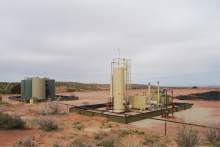This is an archived article that was published on sltrib.com in 2014, and information in the article may be outdated. It is provided only for personal research purposes and may not be reprinted.
A Moab energy company is testing a novel method of fracking at its booming oil field outside Canyonlands and Dead Horse Point State Park.
The experimental extraction method — injecting oil rather than chemical-laden water underground — has shaken environmentalists already worried about the industrialization of a scenic area.
Fidelity Exploration and Production Co.'s wells on Big Flat have been among the nation's most productive in 2012. But more recently drilled bores haven't been yielding as much crude lately.
So last week, the company injected fluids in a well near Dead Horse Point in hopes of "stimulating" its outflow, according to Fidelity officials.
The hydrocarbon formation outside Moab, known as Paradox Basin, contains naturally occurring fissures that can be damaged by water, according to company spokesman Tim Rasmussen.
"We needed to find a fluid that would not damage the reservoir while at the same time being environmentally benign," he said.
With fracking, fluids are pumped under extreme pressure into sandstone formations to force fissures that allow trapped oil and gas to flow into the well bore. The technique is credited with spurring a boom in domestic oil and natural gas production and subsequently declining prices.
But the process is fraught with controversy. Critics say fracking is not adequately regulated as companies inject vast amounts of chemical-laden fluids that could contaminate groundwater.
Fidelity's engineers settled on a 2,200-barrel mixture of crude from the well itself and food-grade oil — a far smaller volume than is usually used in a water-based fracking operation.
Still, environmentalists say public land managers should study the impact of oil fracking before the company goes any further.
Local activist Bill Love is concerned fracking fluids could escape the well bore and migrate toward the two major rivers that pass through the area's two national parks and two national recreation areas and provide water for millions.
"BLM has not done a study. The National Park Service needs to have a study," said Love, who co-founded the Canyon Country Coalition for Pipeline Safety.
Drilling started on Big Flat in the early 1960s, but it wasn't until Fidelity took over the Cane Creek unit in the late 2000s that wells there became a commercial success — without the help of a single fracking system or even a pump jack in many cases.
Rasmussen said past operators have fracked the Paradox formation, but without success.
Fidelity's newly fracked well was completed last spring. Monthly production started with 4,144 barrels in April and steeply tapered to 1,165 barrels by September, according to state records.
The well descends 7,500 vertical feet into the oil reservoir then bends 90 degrees and travels laterally in a northeasterly direction for another 5,000 feet through the reservoir.
Fidelity injected the oil only in the toe of that horizontal leg, the half farthest from the vertical bore.
The well will remain shut in while it stabilizes, then it will be "flowed back."
"Initial flow-back rates will be controlled and monitored," Rasmussen said. "These rates will be compared to production before the treatment to determine the effectiveness of the experimental design."
If production improves, Fidelity may try the technique elsewhere on Big Flat.
"We do not believe that the Big Flat wells are good candidates for traditional massive fracture treatments," Rasmussen said. "The purpose of this stimulation is different and, if successful, could result in better recovery from our existing wells."
Fracking with water would leave a much larger footprint than what Fidelity is pursuing, the company maintains. It takes at least 1 million gallons of water, often loaded with diesel, methanol, surfactants, gelling agents and other chemicals, to frack a well.
Water is scarce in Grand County and places to dispose of spent fracking water are even scarcer.
Rasmussen said the frack oil can be recovered and sold, therefore the operation won't deplete local water supplies nor pose a disposal burden.
But local environmentalists remain concerned about the lack of an environmental analysis of the operation and the possibility of fracking fluids fouling groundwater.
Most of the 100-square-mile oil field is on federal land checkerboarded with state sections. The fracked well, known as Cane Creek 32-1, is on state land and could be fracked without Bureau of Land Management approval.
The state Division of Oil, Gas and Mining reviewed Fidelity's plan and signed off on it, agency spokesman Jim Stringer said.
Wells are fracked daily elsewhere in Utah. But Big Flat is different. It's located at the doorstep of cherished pristine lands, including Canyonlands' Island in the Sky, on a plateau 2,000 feet above the Colorado and Green rivers.
Moab activist Love notes two "beautiful" springs are in the area — one in Hell Roaring Canyon and another outside Upheaval Dome.
"They have not taken baseline samples from the springs," Love said.
Love's group already is grappling with Fidelity over a network of pipelines the BLM has approved to move copious volumes of natural gas that come up with the oil and are flared at the wellheads.
At least 18 wells are producing oil on Big Flat and Fidelity drills non-stop there. BLM predicts another 50 wells are on the way.
Fidelity's parent, MDU Resources Group, recently announced plans to sell the company that has been spending heavily on Big Flat. Despite a $150 million investment this year, daily production has inched up just 5 percent to 2,400 barrels, according to its most recent financial disclosure to investors.



